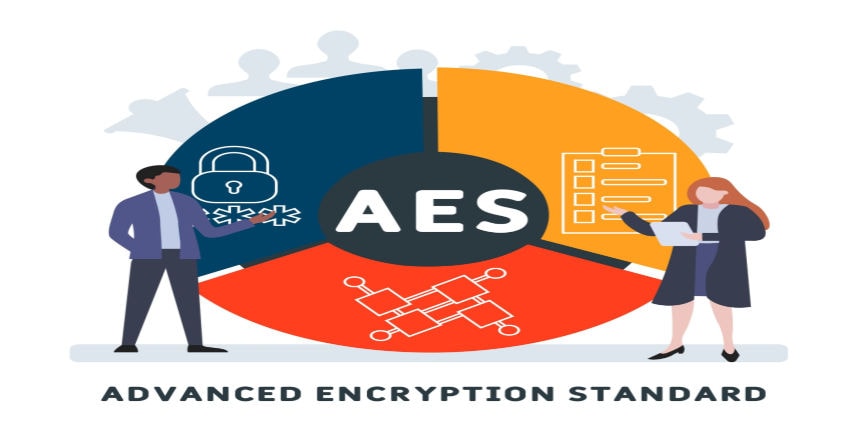AES Full Form
What Is The Full Form Of AES?
The full form of AES is Advanced Encryption Standard. It is found to encrypt and guard digital data. It is likewise used as a substitute for the Data Encryption Standards (DES).
The AES has 3 block ciphers that offer records encryption- making AES higher and quicker than DES. The United States authorities followed this specification. The set of rules that AES describes is a symmetric-key one. The equal key works for each decrypting and encrypting the records.
History of AES
In 1997 The National Institute of Standards and Technology ( NIST) found AES. AES initially geared closer to converting the DES (Data Encryption Standard) for the purpose that specification grew to be gradual and prone to assaults. Thus, an ultra-modern encryption set of regulations- the AES, came into life to overcome the shortcomings of DES. The AES encryption set of regulations was ultimately published on 26 November 2001.
- What Is The Full Form Of AES?
- History of AES
- Characteristics of AES
- Advantages of AES
- Disadvantages of AES
- Number of Rounds in AES
- Definitive Standards
- Performance

Characteristics of AES
The safety supplied with the aid of using AES is excessive so, many assaults are prevented. It has 3 lengths. These are 128, 192, and 256 bits in length. AES is notably flexible. The AES has implementations for each hardware and software. One can without difficulty use it globally because it doesn't have a copyright. It includes ten rounds of processing for the 128-bit keys.
Advantages of AES
AES gives safety at a very excessive level.
A consumer can use each hardware and software.
It includes a sturdy algorithm.
AES gives one of the excellent solutions (open source) for encryption.
Disadvantages of AES
AES is not clean to enforce on software.
The requirements for AES call for numerous rounds of processing.
It calls for greater processing at each and every step.
AES turns into complicated to enforce while thinking about the performance.
Number of Rounds in AES
In an AES cipher, the important length used specifies the whole variety of transformation rounds required to transform the input (additionally referred to as the plaintext) to the very last output (referred to as the ciphertext). Here are the variety of rounds:
- 256-bit keys – 14 rounds
- 192-bit keys – 12 rounds
- 128-bit keys – 10 rounds
Every spherical incorporates numerous steps of processing. It additionally consists of the only one that relies upon the encryption key itself. For reworking the ciphertext lower back to its authentic plaintext, possibly observe a fixed of opposite rounds with the identical encryption key.
Definitive Standards
The Advanced Encryption Standard (AES) is described in every of the:
- FIPS PUB (Federal Information Processing Standards Publications)197: Advanced Encryption Standard (AES)
- The International Organization for Standardization and International Electrotechnical Commission 18033-3: Block ciphers
Performance
High pace and occasional Random access memory necessities had been a number of the standards of the AES choice process. As the selected algorithm, AES has done nicely on an extensive style of hardware, from 8-bit clever playing cards to high-overall performance computers.
Frequently Asked Questions (FAQs)
Particularly 4 steps utilized in AES.
They are
(1) byte substitution,
(2) shift rows,
(3) blend columns, and
(4) upload a spherical key.
One of the maximum steady encryption types, Advanced Encryption Standard (AES) is utilized by governments and safety companies in addition to regular agencies for categorized communications.
AES has in no way been cracked but is secure towards any brute pressure assaults opposite to perception and arguments. However, the important length used for encryption has to continually be huge enough that it couldn't be cracked with the aid of using present-day computer systems in spite of thinking about improvements in processor speeds primarily based totally on Moore's law.
AES is a symmetric key algorithm, which means that there's simply one key, used each to encrypt and decrypt. This isn't the same as RSA (Rivest, Shamir, Adleman), in which you've got keys - a personal one and a public one, associated in a selected way. AES keys are truly random bytes. For example, AES-128 makes use of 128-bit.
Banks and different monetary establishments depend on AES encryption to guard their customers` non-public and transactional information. Insurance agencies consisting of Aetna use AES to mitigate threat publicity in unique gadgets which might be used to get the right of entry to consumer information.

